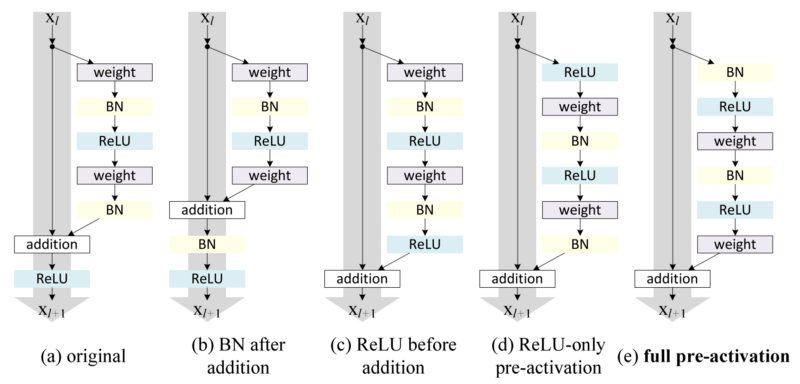In now, this repo contains general architectures and functions that are useful for the GAN and classificstion.
I will continue to add useful things to other areas.
Also, your pull requests and issues are always welcome.
And write what you want to implement on the issue. I'll implement it.
ops.py- operations
- from ops import *
utils.py- image processing
- from utils import *
def network(x, is_training=True, reuse=False, scope="network"):
with tf.variable_scope(scope, reuse=reuse):
x = conv(...)
...
return logitImage_Data_Class = ImageData(img_size, img_ch, augment_flag)
trainA_dataset = ['./dataset/cat/trainA/a.jpg',
'./dataset/cat/trainA/b.png',
'./dataset/cat/trainA/c.jpeg',
...]
trainA = tf.data.Dataset.from_tensor_slices(trainA_dataset)
trainA = trainA.map(Image_Data_Class.image_processing, num_parallel_calls=16)
trainA = trainA.shuffle(buffer_size=10000).prefetch(buffer_size=batch_size).batch(batch_size).repeat()
trainA_iterator = trainA.make_one_shot_iterator()
data_A = trainA_iterator.get_next()
logit = network(data_A)- See this for more information.
padding='SAME'- pad = ceil[ (kernel - stride) / 2 ]
pad_type- 'zero' or 'reflect'
sn- use spectral_normalization or not
- If you don't want to share variable, set all scope names differently.
weight_init = tf.truncated_normal_initializer(mean=0.0, stddev=0.02)
weight_regularizer = tf.contrib.layers.l2_regularizer(0.0001)
weight_regularizer_fully = tf.contrib.layers.l2_regularizer(0.0001)Xavier: tf.contrib.layers.xavier_initializer()USE """tf.contrib.layers.variance_scaling_initializer()""" if uniform : factor = gain * gain mode = 'FAN_AVG' else : factor = (gain * gain) / 1.3 mode = 'FAN_AVG'
He: tf.contrib.layers.variance_scaling_initializer()if uniform : factor = gain * gain mode = 'FAN_IN' else : factor = (gain * gain) / 1.3 mode = 'FAN_OUT'
Normal: tf.random_normal_initializer(mean=0.0, stddev=0.02)Truncated_normal: tf.truncated_normal_initializer(mean=0.0, stddev=0.02)Orthogonal: tf.orthogonal_initializer(1.0) / # if relu = sqrt(2), the others = 1.0
l2_decay: tf.contrib.layers.l2_regularizer(0.0001)orthogonal_regularizer: orthogonal_regularizer(0.0001) & orthogonal_regularizer_fully(0.0001)
x = conv(x, channels=64, kernel=3, stride=2, pad=1, pad_type='reflect', use_bias=True, sn=True, scope='conv')partial conv (NVIDIA Partial Convolution)
x = partial_conv(x, channels=64, kernel=3, stride=2, use_bias=True, padding='SAME', sn=True, scope='partial_conv')x = dilate_conv(x, channels=64, kernel=3, rate=2, use_bias=True, padding='VALID', sn=True, scope='dilate_conv')x = deconv(x, channels=64, kernel=3, stride=1, padding='SAME', use_bias=True, sn=True, scope='deconv')x = fully_connected(x, units=64, use_bias=True, sn=True, scope='fully_connected')x = conv_pixel_shuffle_down(x, scale_factor=2, use_bias=True, sn=True, scope='pixel_shuffle_down')
x = conv_pixel_shuffle_up(x, scale_factor=2, use_bias=True, sn=True, scope='pixel_shuffle_up')down===> [height, width] -> [height // scale_factor, width // scale_factor]up===> [height, width] -> [height * scale_factor, width * scale_factor]
x = resblock(x, channels=64, is_training=is_training, use_bias=True, sn=True, scope='residual_block')
x = resblock_down(x, channels=64, is_training=is_training, use_bias=True, sn=True, scope='residual_block_down')
x = resblock_up(x, channels=64, is_training=is_training, use_bias=True, sn=True, scope='residual_block_up')down===> [height, width] -> [height // 2, width // 2]up===> [height, width] -> [height * 2, width * 2]
x = denseblock(x, channels=64, n_db=6, is_training=is_training, use_bias=True, sn=True, scope='denseblock')n_db===> The number of dense-block
x = res_denseblock(x, channels=64, n_rdb=20, n_rdb_conv=6, is_training=is_training, use_bias=True, sn=True, scope='res_denseblock')n_rdb===> The number of RDBn_rdb_conv===> per RDB conv layer
x = self_attention(x, use_bias=True, sn=True, scope='self_attention')
x = self_attention_with_pooling(x, use_bias=True, sn=True, scope='self_attention_version_2')
x = squeeze_excitation(x, ratio=16, use_bias=True, sn=True, scope='squeeze_excitation')
x = convolution_block_attention(x, ratio=16, use_bias=True, sn=True, scope='convolution_block_attention')
x = global_context_block(x, use_bias=True, sn=True, scope='gc_block')
x = srm_block(x, use_bias=False, is_training=is_training, scope='srm_block')x = batch_norm(x, is_training=is_training, scope='batch_norm')
x = layer_norm(x, scope='layer_norm')
x = instance_norm(x, scope='instance_norm')
x = group_norm(x, groups=32, scope='group_norm')
x = pixel_norm(x)
x = batch_instance_norm(x, scope='batch_instance_norm')
x = layer_instance_norm(x, scope='layer_instance_norm')
x = switch_norm(x, scope='switch_norm')
x = condition_batch_norm(x, z, is_training=is_training, scope='condition_batch_norm'):
x = adaptive_instance_norm(x, gamma, beta)
x = adaptive_layer_instance_norm(x, gamma, beta, smoothing=True, scope='adaLIN')- See this for how to use
condition_batch_norm - See this for how to use
adaptive_instance_norm - See this for how to use
adaptive_layer_instance_norm&layer_instance_norm
x = relu(x)
x = lrelu(x, alpha=0.2)
x = tanh(x)
x = sigmoid(x)
x = swish(x)
x = elu(x)x = nearest_up_sample(x, scale_factor=2)
x = bilinear_up_sample(x, scale_factor=2)
x = nearest_down_sample(x, scale_factor=2)
x = bilinear_down_sample(x, scale_factor=2)
x = max_pooling(x, pool_size=2)
x = avg_pooling(x, pool_size=2)
x = global_max_pooling(x)
x = global_avg_pooling(x)
x = flatten(x)
x = hw_flatten(x)loss, accuracy = classification_loss(logit, label)
loss = dice_loss(n_classes=10, logit, label)g_reg_loss = regularization_loss('generator')
d_reg_loss = regularization_loss('discriminator')- If you want to use
regularizer, then you should write it
loss = L1_loss(x, y)
loss = L2_loss(x, y)
loss = huber_loss(x, y)
loss = histogram_loss(x, y)
loss = gram_style_loss(x, y)
loss = color_consistency_loss(x, y)histogram_lossmeans the difference in the color distribution of the image pixel values.gram_style_lossmeans the difference between the styles using gram matrix.color_consistency_lossmeans the color difference between the generated image and the input image.
d_loss = discriminator_loss(Ra=True, loss_func='wgan-gp', real=real_logit, fake=fake_logit)
g_loss = generator_loss(Ra=True, loss_func='wgan-gp', real=real_logit, fake=fake_logit)Ra- use relativistic gan or not
loss_func- gan
- lsgan
- hinge
- wgan-gp
- dragan
- See this for how to use
gradient_penalty
d_bottleneck_loss = vdb_loss(real_mu, real_logvar, i_c) + vdb_loss(fake_mu, fake_logvar, i_c)loss = kl_loss(mean, logvar)


















